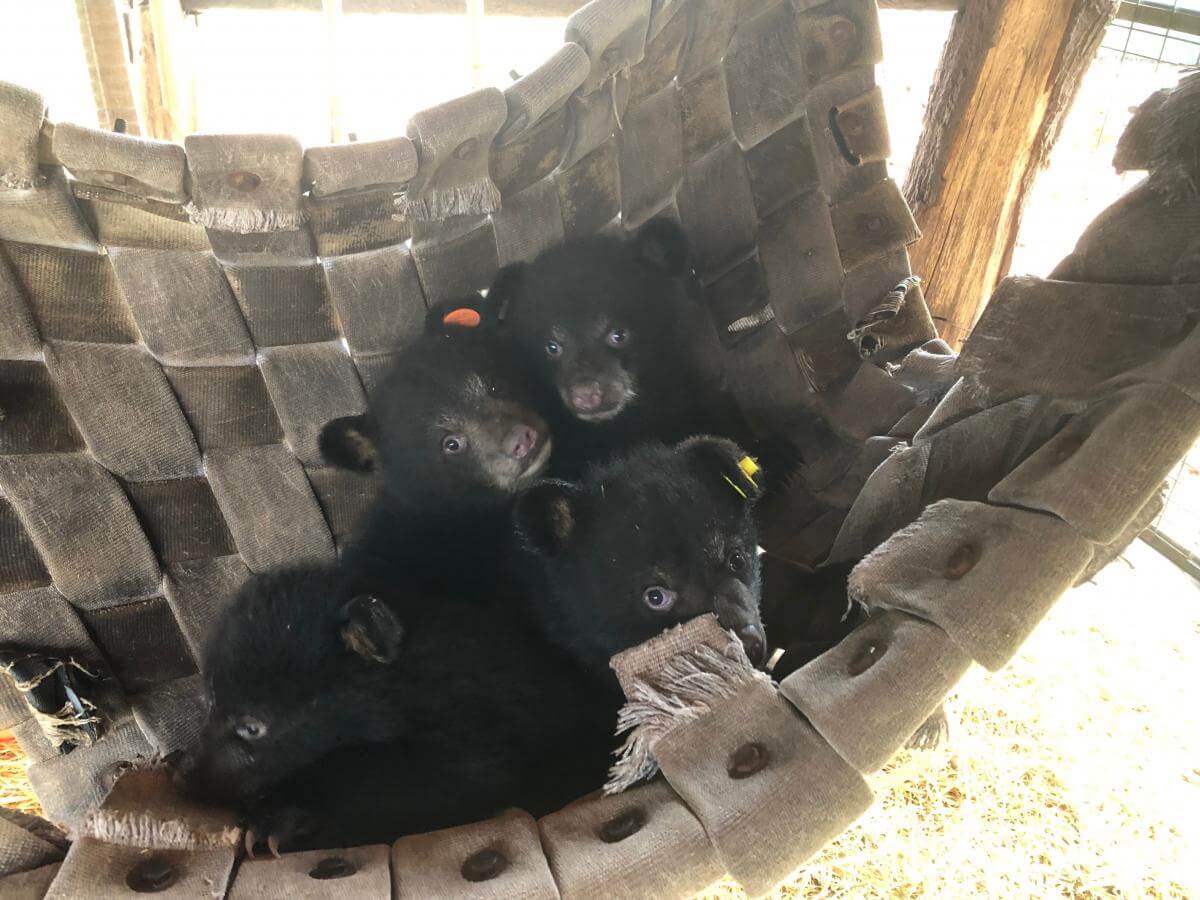
Bear cubs relax in a hammock at the Wildlife Center of Virginia in Waynesboro. Contributed photo.
As bears venture into local areas, state officials advise people to keep their distance
WAYNESBORO – Don’t feed the bears. It seems like common sense, but every year around this time, it becomes a temptation. As fall takes its course, bears start storing enough food for their winter hibernation. In that attempt, often they cross paths with humans.
People in Henry and Franklin counties experienced that situation over the last few weeks. Bears wandered into backyards hunting food, sometimes even going around fences to do so. However, autumn trips along the Blue Ridge Mountains aren’t the only run-in opportunities.
Amanda Nicholson serves as director of outreach at the Wildlife Center of Virginia in Waynesboro. She explained that bears live in places people might not expect.
“There’s some really great habitats in southeastern Virginia, and bears can be found in the Great Dismal Swamp down there – which borders some of the more populated areas,” Nicholson said. “There have been sightings in Virginia Beach and surrounding cities, but generally bears are going to avoid the really densely populated areas where there are many, many humans.”
Bears also inhabit southern and central Virginia areas. In places like Danville, Chatham and Martinsville, residents report multiple bear sighting every year. However, the area isn’t flat like it is near the beach, and there are far more hills than true mountains. It turns out that doesn’t matter much to a bear.
“One aspect bears probably enjoy in that area is having some larger areas of undisturbed habitat – comparatively, anyway – and access to nice forested areas,” Nicholson said. “Bears are pretty adaptable, though, and can be found in a range of habitats.”
From east to west and in between, it’s possible to spot a bear in Virginia.
“They say if you live in Virginia, you live in bear country,” Nicholson said. “Bears can be found in nearly every county in the commonwealth, though the greatest concentrations can be found in the Blue Ridge and Allegheny Mountains, as well as in the Great Dismal Swamp.”
Separate Fact From Fiction: Sign Up For Dogwood’s Newsletter
Nature encounters
Whether hiking, biking or simply walking outside, people across the commonwealth sometimes come face-to-face with a bear. Some folks camp out for days, hoping to catch a glimpse of the animal. Others set out food, trying to pet the bear or get a selfie.
Whether it’s on purpose or by accident, those encountering a wild bear shouldn’t provoke the animal.
“The best thing to do if you see a bear is simply to observe and let it go on its way,” Nicholson said. “Bears aren’t actively seeking humans and generally want to avoid us. They are driven by their motivation to find food though, and that means sometimes that brings them closer to human habitats.”
Sometimes, foraging leads to bear encounters in suburban areas. However, if folks don’t want bears in their backyards, there are certain steps they can take to bear-proof their homes. Or at the very least, make their property less appealing to the animal.
“If bears are visiting your yard or neighborhood, it’s likely due to food. The best way to get a bear to move on is to really make sure you – and your neighbors – eliminate all food sources. Bring in bird feeders, pet food and make sure your trash is secure. Clean the grill too – they are really attracted to strong food scents,” Nicholson said. “If a bear is used to accessing food in a certain area – for example, if a bear is successfully raiding a bird feeder – they are definitely going to be back. So even after you bring the feeder in, you may see the bear around a couple more times before he gets the message and moves on.”

Bears, bears everywhere
Visiting the Wildlife Center of Virginia, guests might mistake the facility for Anne Murray’s famous song. That’s because 19 bears have a picnic at the center every day.
That’s quite a few more cubs than usual, but not as many as it could have been. From January through April, the center saw a large increase in orphaned bear cubs. When possible, they adopted the cubs out to wild bear mothers. That’s typically option number one.
“While we certainly do our best to successfully raise a variety of young wild animals, no one can do it like mom. [That] is why we make every effort to reunite cubs with their moms, and want to make sure we’re not cub-napping a bear cub immediately when one is seen,” Nicholson said. “But yes, in some situations, other bear moms will adopt cubs that are not theirs – their mothering instinct is strong. When we’re able to foster a cub onto a wild mother, that’s an excellent solution for that bear to truly grow up in the wild where it belongs.”
Resources to the rescue
If an adoptive mother isn’t available, staff members at the center rehabilitate the cubs. Plenty goes into that process.
“Bear cubs are a lot of work – and require a lot of food. The cubs we received in the spring of 2020 were bottle-fed for weeks to a month and gradually weaned into an adult bear diet. [That means] lots of natural fruits, veggies, insects, eggs, fish, nuts. Right now, they are eating huge volumes of food as they prepare for the winter. It’s the time of year when they put on a lot of extra weight, so our grocery bills are high,” Nicholson said. “It’s also critically important during the entire process of raising them that we keep the people who interact with them to an absolute minimum. Bears can become habituated to people. By only having a few caretakers, they only get to know those individuals and don’t generalize that all people will bring them food.”
Raising them as naturally as possible, staff members will release the bear cubs into the wild in the spring. The center will coordinate the release with the Virginia Department of Game and Inland Fisheries.
Amie Knowles reports for The Dogwood. You can reach her at [email protected]
Politics

Democratic shakeup in Virginia primaries for governor, lieutenant governor
Richmond Mayor Levar Stoney quit his bid for governor and jumped into the race to be the Democratic nominee for lieutenant governor. The race for...

New Biden rule protects privacy of women seeking abortions
Under the new rules, state officials and law enforcement cannot obtain medical records related to lawful reproductive health care with the goal of...
Local News

Virginia verses: Celebrating 5 poetic icons for National Poetry Month
There’s no shortage of great writers when it comes to our commonwealth. From the haunting verses of Edgar Allan Poe, who found solace in Richmond's...

Join the fun: Recapping Family Literacy Night’s storybook adventures
When’s the last time you read a book aloud with a loved one? If it’s difficult to answer that question, then maybe it’s time to dust off that TBR...





